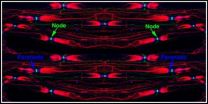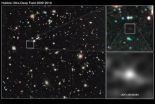(Press-News.org) A new target for the prevention of adverse immune responses identified as factors in the development of Alzheimer's disease (AD) has been discovered by researchers at the University of South Florida's Department of Psychiatry and the Center of Excellence for Aging and Brain Repair.
Their findings are published online in the Journal of Neuroscience (http://www.jneurosci.org/).
The CD45 molecule is a receptor on the surface of the brain's microglia cells, cells that support the brain's neurons and also participate in brain immune responses.
Previous studies by the USF researchers showed that triggering CD45 was beneficial because it blocked a very early step in the development of Alzheimer's disease. In the present study, the researchers demonstrated in Alzheimer's mouse models that a loss of CD45 led to dramatically increased microglial inflammation.
Although the brain's immune response is involved in Alzheimer's disease pathology, "this finding suggests that CD45 on brain immune cells appears critically involved in dampening harmful inflammation," said study senior author Jun Tan, MD, PhD, a professor of psychiatry and Robert A. Silver chair at the Rashid Laboratory for Developmental Neurobiology, USF Silver Child Development Center and research biologist for Research and Development Service at the James A. Haley Veteran's Hospital.
The investigators also found an increase in harmful neurotoxins, such as A beta peptides, as well as neuron loss in the brains of the test mice.
"In short, CD45 deficiency leads to increased accumulation of neurotoxic A beta in the brains of old Alzheimer's mice, demonstrating the involvement of CD45 in clearing those toxins and protecting neurons," Dr. Tan said. "These findings are quite significant, because many in the field have long considered CD45 to be an indicator of harmful inflammation. So, researchers assumed that CD45 was part of the problem, not a potential protective factor."
The next step is to apply these findings to develop new Alzheimer's disease treatments, said Paula Bickford, PhD, a professor in the USF Department of Neurosurgery and senior career research scientist at the James A. Haley Veteran's Hospital.
"We are already working with Natura Therapeutics, Inc. to screen for natural compounds that will target CD45 activation in the brain's immune cells," Dr. Bickford said.
INFORMATION:
Other researchers involved in this study were: Dr. Yuyan Zhu, Dr. Huayan Hou, Dr. Kavon Rezai-zadeh, Dr. Brian Giunta, Ms. Amanda Ruscin, Dr. Carmelina Gemma, Dr. JingJi Jin, Dr. Natasa Dragicevic, Dr. Patrick Bradshaw, Dr. Suhail Rasool, Dr. Charles G. Glabe (University of California, Irvine, CA), Dr. Jared Ehrhart, Dr. Takashi Mori (Saitama Medical Center/Saitama Medical University, Japan), Dr. Demian Obregon, Dr. Terrence Town (Cedars-Sinai Medical Center, Los Angeles, CA). Drs. Yuyan Zhu and Huayan Hou contributed equally to this work.
Their work was supported by the National Institute on Aging and the National Institute of Neurological Disorders and Stroke, National Institutes of Health.
The mission of the Center of Excellence for Aging and Brain Repair is to develop new therapeutic strategies to promote repair and regeneration of aging and diseased brain. Building on a foundation of excellence in basic and clinical research, we focus on translating innovative ideas into industrial partnerships, educational and clinical services to address key needs of the community and those suffering from brain injury and disease.
USF Health
USF Health (www.health.usf.edu) is dedicated to creating a model of health care based on understanding the full spectrum of health. It includes the University of South Florida's colleges of medicine, nursing, pharmacy and public health; the schools of biomedical sciences as well physical therapy & rehabilitation sciences; and the USF Physicians Group. With more than $394.1 million in research grants and contracts in FY2009/2010, the University of South Florida is one of the nation's top 63 public research universities and one of only 25 public research universities nationwide with very high research activity that is designated as community-engaged by the Carnegie Foundation for the Advancement of Teaching.
CHAPEL HILL, N.C. -- New research from the University of North Carolina at Chapel Hill School of Medicine describes a key molecular mechanism in nerve fibers that ensures the rapid conductance of nervous system impulses. The findings appear online Jan. 27, 2011 in the journal Neuron.
Our hard-wired nerve fibers or axons rely on an insulating membrane sheath, the myelin, made up of fatty white matter to accelerate the rate of transmission of electrical impulses from the brain to other parts of the body.
Myelin thus acts to prevent electrical current from leaking or prematurely ...
Scientists are reporting discovery of a potential biochemical basis for the apparent cancer-fighting ability of broccoli and its veggie cousins. They found for the first time that certain substances in the vegetables appear to target and block a defective gene associated with cancer. Their report, which could lead to new strategies for preventing and treating cancer, appears in ACS' Journal of Medicinal Chemistry.
Fung-Lung Chung and colleagues showed in previous experiments that substances called isothiocyanates (or ITCs) — found in broccoli, cauliflower, watercress, ...
Scientists are reporting that key chemical components of the 770,000 gallons of oil dispersants applied below the ocean surface in the Deepwater Horizon spill did mix with oil and gas spewing out of the damaged wellhead and remained in the deep ocean for two months or more without degrading. However, it was not possible to determine if the first deep ocean use of oil dispersants worked as planned in breaking up and dissipating the oil. Their study, the first peer-reviewed research published on the fate of oil dispersants added to underwater ocean environments, appears in ...
Scientists are reporting successful application of the technology used in home devices to clean jewelry, dentures, and other items to make anticancer drugs like tamoxifen and paclitaxel dissolve more easily in body fluids, so they can better fight the disease. The process, described in ACS' journal, Langmuir, can make other poorly soluble materials more soluble, and has potential for improving the performance of dyes, paints, rust-proofing agents and other products.
In the report, Yuri M. Lvov and colleagues point out that many drugs, including some of the most powerful ...
Phosphate-free automatic dishwashing detergents — introduced to combat the phosphate-fed algae blooms that foul the nation's lakes and rivers — may be making the fish happy. But they're putting a frown on the faces of some consumers who say the new products leave dishes dirty. That's the topic of the cover story in the current edition of Chemical & Engineering News (C&EN), ACS' weekly newsmagazine.
C&EN Assistant Managing Editor Michael McCoy described how new laws in 16 states require manufacturers to eliminate phosphates from automatic dishwasher detergents sold in ...
Astronomers have pushed the NASA/ESA Hubble Space Telescope to its limits by finding what is plausibly the most distant and ancient object in the Universe [1] ever seen. Its light has travelled for 13.2 billion years to reach Hubble [2], which corresponds to a redshift around 10. The age of the Universe is 13.7 billion years.
The dim object, called UDFj-39546284, is likely to be a compact galaxy of blue stars that existed 480 million years after the Big Bang, only four percent of the Universe's current age. It is tiny. Over one hundred such mini-galaxies would be needed ...
Cardiac arrests that can be treated by electric stimulation, also known as shockable arrests, were found at a higher frequency in public settings than in the home, according to a National Institutes of Health-funded study appearing in the Jan. 27 issue of the New England Journal of Medicine.
The study compared home and public cardiac arrests under various scenarios. For example, the study considered whether bystanders or emergency medical services (EMS) personnel witnessed the cardiac arrest, and whether the person experiencing the arrest received treatment with an automatic ...
Pasadena, CA— Astronomers have pushed NASA's Hubble Space Telescope to it limits by finding what they believe to be the most distant object ever seen in the universe—at a distance of 13.2 billion light years, some 3% of the age of universe. This places the object roughly 150 million light years more distant than the previous record holder. The observations provide the best insights yet into the birth of the first stars and galaxies and the evolution of the universe. The research is published in the 27th January edition of Nature.
The dim object is a compact galaxy made ...
NASA's Aqua Satellite captured a visible image of the former Tropical Storm Anthony, now weakened to a tropical depression, but forecasters aren't counting Anthony out yet. Despite its weakened condition Anthony continues to move west toward Queensland, Australia and into a more favorable area for sustaining a tropical cyclone.
The Atmospheric Infrared Sounder (AIRS) instrument that flies aboard NASA's Aqua satellite captured a visible image on Jan. 26 at 03:23 UTC of Tropical Depression Anthony in the South Pacific Ocean. The image revealed a cloud-filled center of the ...
The life of a cyclone is a complex one, and NASA satellites have kept track of a low that has now become Tropical Storm Bianca just off the northern coast of Western Australia.
What began as a low pressure system designated as System 98S on January 24, brought rains near Kuri Bay, Australia. On January 25, System 98S strengthened into the tenth tropical depression of the Southern Pacific Ocean hurricane season and was designated as "10S." Today, January 26, that low intensified into a tropical storm and was named Bianca.
NASA's Tropical Rainfall Measuring Mission (TRMM) ...





